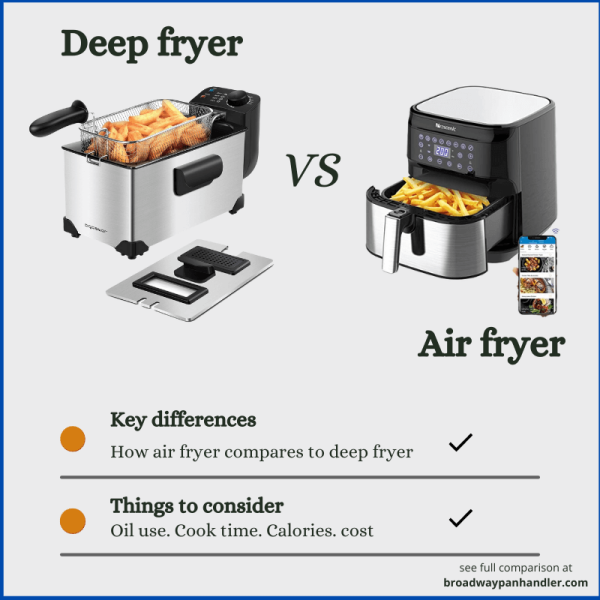In the world of cooking, there’s always a new trend that promises a healthier way to indulge in our favorite foods. Enter air frying – a method that claims to deliver the crispiness of deep frying with a fraction of the oil. But is it truly a healthier alternative? In this article, we’ll explore the age-old debate and uncover the truth behind whether air frying is actually healthier than deep frying.
This image is property of www.broadwaypanhandler.com.
Definition of Air Frying and Deep Frying
What is air frying?
Air frying is a cooking method that uses hot air circulation to cook food. It involves the use of an air fryer, a countertop appliance equipped with a heating element and a fan. The heating element generates the hot air, which is then circulated throughout the cooking chamber by the fan. This innovative cooking technique helps to mimic the results of deep frying by creating a crispy exterior while using significantly less oil. The food is placed in a basket or on a rack inside the air fryer, allowing the hot air to cook it evenly from all sides.
What is deep frying?
Deep frying, on the other hand, is a traditional cooking method that involves submerging food in hot oil. The oil is typically heated to a high temperature, often around 350-375 degrees Fahrenheit, which quickly cooks the food and creates a crispy outer coating. Deep frying is commonly done in a deep fryer or a pot filled with oil. The food is fully immersed in the oil, which results in a rich, indulgent flavor and a crunchy texture.
Cooking Method
Air frying process
When it comes to the air frying process, the food is cooked using hot air that circulates rapidly around it. The air fryer’s heating element heats the air to the desired temperature, while the fan ensures even distribution of heat. The circulated hot air rapidly evaporates the moisture on the food’s surface, creating a crisp exterior. The result is food that is cooked through and crispy on the outside, similar to deep-fried food, but with significantly less oil.
Deep frying process
Deep frying involves submerging the food completely in hot oil. The oil’s high temperature quickly cooks the food and seals the outer surface, creating a crispy texture. The heated oil slowly penetrates the food, locking in moisture and intensifying flavors. Due to the oil’s direct contact with the food, deep frying can achieve a faster cooking time compared to other methods. However, it requires a larger amount of oil, which can vary depending on the size of the fryer or the amount of food being cooked.
Health Implications
Oil consumption
One of the significant differences between air frying and deep frying is the amount of oil used. Air frying requires minimal oil, typically only using a tablespoon or less. In contrast, deep frying involves submerging the food in a significant amount of oil, which adds a considerable number of calories and fat to the final product. This difference in oil consumption makes air frying a healthier option in terms of reducing overall caloric intake and fat content.
Calorie content
Deep-fried foods are known for their high calorie content due to the absorption of oil during cooking. On the other hand, air frying significantly reduces the calorie content of food by using minimal oil. By using hot air circulation to cook food, air frying can achieve a similar crispy texture with fewer calories. For those who are conscious of their calorie intake, air frying provides a guilt-free alternative to traditional deep-fried dishes.
Nutritional value
Air frying and deep frying do not significantly alter the nutritional value of the food itself. Both methods primarily affect the texture and taste of the food, rather than its nutrient composition. However, air frying can be considered a healthier cooking method since it requires less oil, which can help in reducing the overall fat content of the dish. By minimizing the amount of oil used, air frying allows the natural flavors and nutrients of the food to shine through.
Impact on heart health
Excessive consumption of deep-fried foods has been linked to an increased risk of heart disease due to the high levels of unhealthy fats and calories. Air frying offers a heart-friendlier alternative by reducing the amount of oil used in cooking. By using hot air instead of oil to create a crispy exterior, air frying eliminates the need for large amounts of artery-clogging fats. Choosing air frying over deep frying can be a beneficial choice for individuals concerned about maintaining heart health.
Effect on blood pressure
The high sodium content in deep-fried foods, such as French fries and fried chicken, can contribute to elevated blood pressure levels. The excessive consumption of salty deep-fried dishes can be detrimental to individuals with hypertension or those at risk of developing high blood pressure. By minimizing oil usage and relying on hot air circulation, air frying can reduce the sodium intake associated with deep frying, making it a more blood pressure-friendly cooking method.
Formation of acrylamide
Acrylamide is a potentially harmful chemical compound that forms during high-temperature cooking processes, such as deep frying and baking. It is formed when certain starchy foods, like potatoes or bread, are cooked at temperatures above 248 degrees Fahrenheit. The browning and crisping that occur during deep frying can contribute to acrylamide formation. Air frying presents a safer alternative, as the lower temperatures used in this cooking method can significantly reduce acrylamide production.
Cancer risk
Deep frying has been associated with an increased risk of certain types of cancers, including prostate, breast, and gastrointestinal cancers. This is primarily due to the potential formation of acrylamide in deep-fried foods, which is classified as a probable human carcinogen. By choosing to air fry rather than deep fry, individuals can minimize their exposure to acrylamide, reducing the associated cancer risks.
Texture and Taste
Crispiness
Both air frying and deep frying can deliver a deliciously crispy exterior on food. Deep frying, with its immersion in hot oil, tends to create a slightly crispier texture. However, air frying can come remarkably close to replicating the crispy result by using hot air circulation and a minimal amount of oil. The difference in crispiness is minimal, and most individuals find the air-fried version to be satisfyingly crunchy.
Moisture retention
Deep frying can cause moisture loss in food due to the high temperatures and prolonged cooking time. The excessive oil absorption during deep frying can also result in a drier end product. Air frying, on the other hand, helps retain the food’s moisture by cooking it rapidly using hot air. This method allows for better moisture retention, resulting in a juicier and more succulent final product.
Flavor enhancement
Deep frying is often associated with indulgent and intense flavors. The immersion in hot oil amplifies the food’s natural flavors and adds a distinctive taste. Air frying, although using less oil, can still enhance the food’s flavors. The use of minimal oil allows the natural tastes to shine through without overpowering the dish. Additionally, air frying can create a beautiful golden-brown exterior that enhances the visual appeal and overall eating experience.
Cooking time
In terms of cooking time, air frying tends to be faster compared to deep frying. The hot air circulation in an air fryer allows for even and efficient cooking, reducing the overall cooking time required. Deep frying typically takes longer due to the slower heat transfer within the oil. This makes air frying a convenient option for those looking for a quick and efficient cooking method.
This image is property of www.eatthis.com.
Use of Oil
Air fryer oil requirement
Air frying requires minimal oil, usually only a tablespoon or less. The small amount of oil is used to coat the food or sprayed onto the surface to help achieve a crispy texture. This minimal oil requirement makes air frying a healthier option, as it significantly reduces the overall fat and calorie content of the dish.
Deep fryer oil requirement
Deep frying, on the other hand, requires a substantial amount of oil. The exact quantity of oil needed depends on the size of the deep fryer and the amount of food being cooked. Typically, a deep fryer requires enough oil to fully submerge the food, ranging from one to several liters. This large quantity of oil adds a significant amount of calories and fats to the final product.
Cooking Convenience
Ease of use
Air fryers are designed with user-friendliness in mind. Most models come with pre-programmed settings and intuitive controls, making them easy to operate. Air frying also eliminates the need for constant monitoring and flipping of food, as the hot air circulation ensures even cooking from all sides. Deep frying, while straightforward, requires careful temperature regulation and constant supervision to prevent overcooking or burning.
Cleaning process
When it comes to cleaning, air fryers have the upper hand. Since air frying requires a minimal amount of oil, there is considerably less oil residue left inside the cooking chamber. Most air fryer components are also dishwasher-safe, making the cleaning process quick and hassle-free. Deep fryers, on the other hand, can be more challenging to clean due to the excessive oil residue and the need to handle large volumes of oil.
Variety of food
Both air frying and deep frying can accommodate a wide range of foods. Air fryers can handle anything from fries and chicken wings to vegetables and even desserts. The rapid hot air circulation allows for versatile cooking options. Deep frying, although often associated with indulgent foods like fried chicken and donuts, can also be used to cook a variety of dishes. From onion rings to seafood, deep frying opens up opportunities for creating crispy delights.
This image is property of health.clevelandclinic.org.
Safety Concerns
Fire hazard
Deep frying poses a potential fire hazard due to the high temperature of the oil involved. If not monitored closely, oil can reach its ignition point and cause a fire. On the other hand, air frying significantly reduces this risk since it only requires a small amount of oil, lowering the probability of any ignition. The absence of an open flame in air fryers further enhances safety during the cooking process.
Risk of burns
Both air frying and deep frying involve dealing with hot temperatures, so there is always a risk of burns. Deep frying poses a higher risk due to the larger volumes of hot oil used. Accidental splatters or spills can cause severe burns. While air frying also requires caution, the risk of burns is comparatively lower since the hot air is enclosed within the cooking chamber. However, it is still crucial to follow safety precautions and handle the air fryer with care.
Smoke and odor emission
Deep frying can emit smoke and strong odors during the cooking process. The high temperatures involved can cause the oil to splatter and release particles into the air, resulting in smoke and lingering smells. Air frying, on the other hand, generates minimal smoke and emits less odor. The enclosed cooking environment of the air fryer helps contain any smoke or odors produced, ensuring a more pleasant cooking experience.
Impact on Environment
Energy consumption
Air frying is generally more energy-efficient compared to deep frying. Air fryers use a heating element and a fan to circulate hot air, which requires less energy compared to heating and maintaining a large volume of oil in a deep fryer. The shorter cooking time associated with air frying also contributes to its energy efficiency.
Waste generation
Deep frying can generate a significant amount of waste due to the disposal of used oil. The leftover oil from deep frying cannot be reused indefinitely and needs to be properly disposed of once it becomes unfit for cooking. Air frying, on the other hand, generates minimal waste since it uses minimal oil. Any residual oil can be easily wiped away, and the air fryer components can be cleaned and reused.
Carbon footprint
The energy efficiency and reduced waste generation of air frying make it a more environmentally friendly cooking method compared to deep frying. By consuming less energy and generating less waste, air frying helps reduce carbon emissions and minimize the overall environmental impact of cooking. Choosing air frying over deep frying can be a small but meaningful step towards sustainable and greener cooking practices.
This image is property of post.medicalnewstoday.com.
Considerations for Specific Diets
Keto diet
The keto diet is a low-carb, high-fat diet that aims to induce a state of ketosis in the body. Air frying can be a suitable cooking option for individuals following a keto diet. By using minimal oil and reducing the overall fat content of dishes, air frying aligns well with the principles of the keto diet. It allows for the creation of crispy, low-carb versions of favorite foods without compromising on taste.
Paleo diet
The paleo diet focuses on eating foods that were available to our ancestors during the Paleolithic era, which includes unprocessed and whole foods. Air frying can be compatible with the paleo diet, as it allows for the cooking of fresh meats, vegetables, and other unprocessed ingredients. By relying on hot air circulation and minimal oil, air frying helps maintain the integrity of paleo-friendly ingredients, preserving their natural flavors and nutrients.
Vegetarian or vegan diet
Air frying provides versatile options for individuals following a vegetarian or vegan diet. It allows for the preparation of crispy plant-based alternatives to meat, such as air-fried tofu or vegetable fritters. The ability to achieve a crunchy exterior without excessive oil can create delightful vegetarian or vegan dishes. Additionally, air frying ensures that the natural flavors of fruits, vegetables, and plant-based proteins are enhanced without relying on animal products.
Gluten-free diet
For individuals with gluten sensitivities or celiac disease, air frying can be an excellent cooking method. Many gluten-free foods, such as fries, chicken nuggets, and vegetable chips, can be air-fried to achieve a crispy texture without the need for gluten-containing ingredients. Air frying offers a gluten-free alternative that allows individuals with dietary restrictions to enjoy their favorite dishes without compromising their health.
Conclusion
In conclusion, air frying has gained popularity as a healthier alternative to deep frying. With its ability to create crispy and delicious food using minimal oil, air frying offers a guilt-free indulgence for those seeking a healthier lifestyle. The reduction in oil consumption, calorie content, and potential risks associated with deep frying make air frying an appealing option for health-conscious individuals. Additionally, the convenience, ease of use, and environmental advantages of air frying further contribute to its appeal. Ultimately, personal preference and individual dietary concerns should guide the choice between air frying and deep frying, ensuring that everyone can enjoy their favorite dishes while maintaining a healthy and balanced diet.
This image is property of www.corriecooks.com.










































